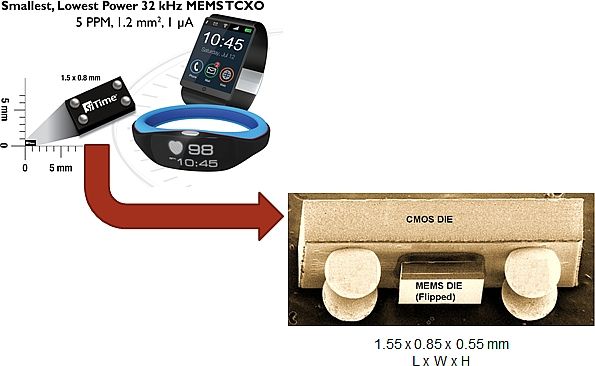I recently spoke to Piyush Sevalia, Executive Vice President, Marketing at SiTime Corporation,about their newly introduced 32 kHz TCXO (temperature compensated oscillator) which they claim to be the smallest, lowest power device in the industry. With its tiny footprint and ultra-low power consumption, the SiT1552 MEMS TCXO decreases the size and increases battery life of wearable electronics and Internet of Things (IoT); such benefits are not achievable from legacy quartz devices.
The company uses its TempFlat MEMSTM (See my article on SiTime’s MEMS Resonators: An alternative to Quartz) and analog technology to attain some really excellent specifications. The SiT1552 MEMS TCXO is 20% of the size and consumes 50% of the power of comparable quartz devices. See Figure 1 for the architectural diagram of this device.
Stability over temperature
Here is the amazing accomplishment in this device. The previous solution which is still a good solution for many designs is the SiT153x, a 32 kHz XO @ 100 ppm stability—this device is great for the mobile and tablet market. The newer device SiT1552, a 32 kHz TCXO has +/- 5 ppm stability—-wearables, sport fitness, personal medical devices, accessories and the IoT and are the market for this device where ultimate accuracy, increased battery life and small size are critical. See Figure 2.
Figure 2: The SiT153x frequency stability over temperature vs. the SiT1552
The following video tells the complete story about this device:
The device is available in a 1.5 x 0.8 mm chip scale package (CSP). See Figure 3.
Figure 3: Showing the unique packaging to obtain the smallest size possible
The device can perform various functions in a system such as:
- Reference for real time clock (RTC) function
- Sleep clock for connectivity – Bluetooth, Bluetooth Low Energy, WiFi
- Heartbeat clock for battery supervisory function
Extending battery life
Now we get to one of the most important aspects of this design—extending battery life of the device in which it will reside. This is what really blew my mind. Here is how it does just that:
- Problem: Frequent network connections consume power, limits battery life.
- Solution: 5 PPM 32kHz sleep-clock maximizes battery life
- On Time and Sleep Time are defined in BLE standards
- Early On Time is penalty due to clock inaccuracy (worse stability)
- Tighter Stability à Shorter Early On Time à Lower Power
For more detail: SiTime enters wearables, IoT markets with 32 kHz MEMS TCXO

